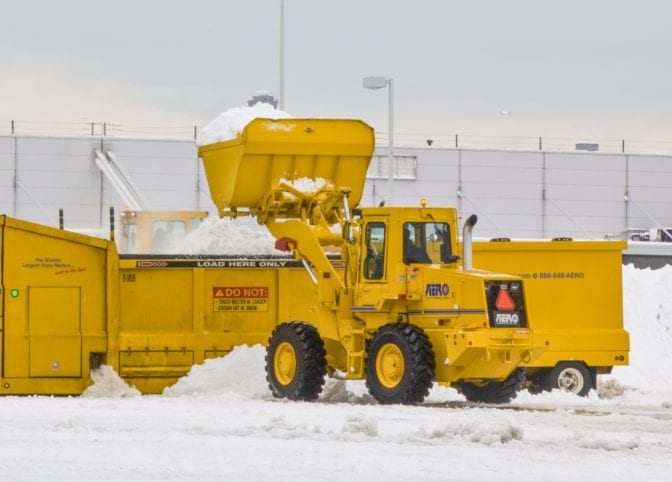 It’s crucial for crew leaders in blizzard-prone areas to wield a severe weather emergency action plan. Doing so will help you make preparations to best protect construction projects, and most importantly, keep you and your workers safe.
It’s crucial for crew leaders in blizzard-prone areas to wield a severe weather emergency action plan. Doing so will help you make preparations to best protect construction projects, and most importantly, keep you and your workers safe.
With your busy schedule, shutting down operations during winter isn’t always an option. So, you must prepare for cold weather, strong winds, heavy snow and slick ice, which can lead to project delays and job site hazards.
If you don’t plan early on, unpredictable Old Man Winter can make it difficult to finish a project on time and within budget. This blog post will help you develop a plan to properly evaluate risks and secure materials before winter storms hit.
Train your employees to operate in winter conditions
Employees need to be trained on how to operate construction equipment during winter, according to the Occupational Safety and Health Administration (OSHA). One way to do this is have your workers practice navigating equipment in an empty parking lot. Seasoned crew members can also be helpful by teaching newer employees.
Additionally, it’s important for you and your crew to recognize signs and heed warnings of extreme weather. The entire crew should be actively monitoring winter weather conditions and have reliable ways to communicate with one another in case they need to evacuate the job site or move equipment.
Everyone should also be able to recognize public winter weather warnings, such as sirens, radio alerts and TV weather forecasts. You should take these warnings seriously, adjusting your schedules, PPE requirements and other factors accordingly.
Employees should know how to prevent hypothermia and frostbite, and you should download these free and helpful tools for winter shift scheduling.
Prepare for strong winds
Strong winter winds can cause unsecured construction materials to be thrown around, which can be a hazard and liability. The following are among the materials that should be properly secured if severe weather is expected:
- Machinery
- Scaffolding
- Masonry walls
- Structural steel
- Forms
- Roofing
- Fencing
- Gutters
- Site offices
- Shipping containers
These items should be properly secured and inspected at the end of each day. Here are some common secure measures you can take:
- Apply shade cloth throughout your job site to help minimize wind resistance.
- Set cranes to slew mode to allow for movement in high winds.
- Secure any suspended loads.
- Cover and secure soil, cement, sand and gravel with strong fabric.
- Cover large wall openings with tarp until windows or doors are installed.
- If possible, avoid operating large equipment during an extreme winter weather event.
Be sure to follow these best practices in the event of an impending winter storm.
Beware of ice
It’s difficult to install a fence or other structures when the ground is frozen. Do your best to complete any ground-related processes before the ground freezes. Alternatively, you want to be prepared to handle muddy conditions after the ground starts to thaw. This will help keep your machinery from getting stuck in the mud.
It’s helpful to have rock salt and kitty litter on hand ahead of time. The rock salt will melt ice and kitty litter will provide additional traction for your workers and machinery. Gravel can also be used to make pathways for better traction.
It’s worth noting that crew members should avoid working on elevated surfaces that are covered with ice or snow. If workers must operate in potentially icy areas, they should have proper traction footwear to reduce their chances of slipping. It’s important to take short, slow steps to remain balanced in icy conditions and your crew should also create clear travel paths around the job site.
Ensure structural integrity in freezing temperatures
While certain winter construction tasks can be completed with enough strategically placed warming equipment, tasks involving concrete and masonry work can fail if the right precautions aren’t taken. To reach certain strength levels, concrete can’t be allowed to freeze for the first 24 hours after being poured. The same principle that applies to masonry.
Freezing temperatures can also affect paint and drywall finishing materials. Temperature and humidity hinder drying time, and when faced with low-enough temperatures, paint can be susceptible to issues like mildew growth. Construction crews should follow manufacturers’ guidelines when approaching these tasks in freezing temperatures.
Use caution when operating vehicles and equipment
In addition to being trained and properly licensed, vehicle and equipment drivers should ensure the following:
- Vehicles are maintained and stocked with flashlights, flares, jumper cables, blankets, nonperishable food and water.
- Tires are inflated to the proper pressure levels.
- Batteries are charged.
- Vehicle lights are tested.
- Windshield visibility is maximized.
When operating construction equipment following a winter storm, it’s also important to account for ditches and hills that might be hidden by perfectly leveled snow. Before storms hit, be sure to fill ditches in with stone and mark their location.
Additionally, your job site should have pre-established plowing areas. When it comes to piling snow, operators should do so in an inclining way so that snow runs away from the job site when it melts. Use temporary drainage systems when necessary and be sure to remove trash and debris from piles as snow melts.
Takeaways: Severe weather emergency action plan
When preparing for a winter storm on your job site, be sure to train and protect your employees, prepare for strong winds, beware of ice, ensure structural integrity in cold temperatures and use caution when operating vehicles and equipment.
Related posts
Best winter work gear guide for extremely cold job sites (FREE DOWNLOAD)
Winter shift scheduling tools for safety supervisors (FREE DOWNLOAD)